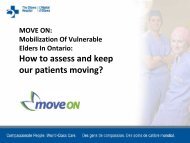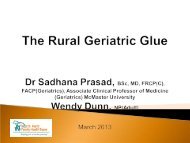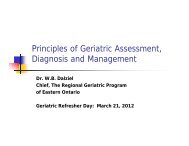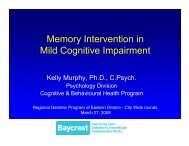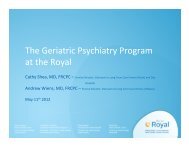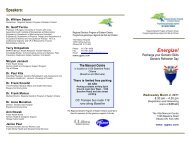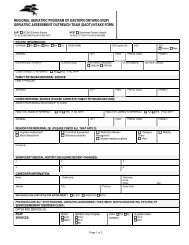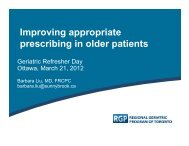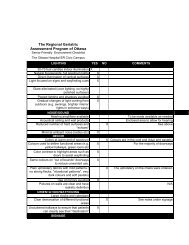Polypharmacy in a Geriatric Day Hospital - Regional Geriatric ...
Polypharmacy in a Geriatric Day Hospital - Regional Geriatric ...
Polypharmacy in a Geriatric Day Hospital - Regional Geriatric ...
You also want an ePaper? Increase the reach of your titles
YUMPU automatically turns print PDFs into web optimized ePapers that Google loves.
Barbara Farrell BScPhm, PharmD, FCSHP<br />
Bruyère <strong>Geriatric</strong> <strong>Day</strong> <strong>Hospital</strong>
What is polypharmacy?<br />
Context: Bruyère <strong>Geriatric</strong> <strong>Day</strong> <strong>Hospital</strong><br />
GDH case reports: objectives and methods<br />
Example of contributions to cases and<br />
outcomes<br />
Cost-analysis – methods and results<br />
Questions and discussion
<strong>Polypharmacy</strong><br />
◦ Concurrent use of > 5-10 medications<br />
◦ Use of ‘<strong>in</strong>appropriate’ medication choices or doses<br />
◦ More medications than cl<strong>in</strong>ically <strong>in</strong>dicated<br />
Associated with…<br />
◦ Adverse drug reactions<br />
◦ Drug <strong>in</strong>teractions<br />
◦ Inappropriate use<br />
◦ Non-adherence<br />
◦ ER and hospital admissions<br />
◦ Significant health care costs
Canadian Institute of Health Information (2009)<br />
◦ 63% of seniors had claims for ≥ 5 drug classes<br />
◦ 23% had claims for ≥ 10 drug classes<br />
◦ 30% of >85 had claims for ≥ 10 drug classes<br />
National Population Health Survey<br />
◦ 5 medications used by 13% of community dwell<strong>in</strong>g and<br />
53% of those <strong>in</strong> <strong>in</strong>stitutions<br />
Ontario Drug Benefit claims<br />
◦ Increased by 214% <strong>in</strong> last decade while those >65<br />
<strong>in</strong>creased by only 18%<br />
At Bruyère GDH, patients referred for medication<br />
assessment take an average of 15 medications
amipril<br />
Need for CV<br />
protection<br />
Cough<br />
ASA<br />
dextromethorphan<br />
Increased blood<br />
pressure<br />
ibuprofen<br />
Need for GI<br />
prophylaxis<br />
amlodip<strong>in</strong>e<br />
Heartburn<br />
lansoprazole<br />
Ankle<br />
swell<strong>in</strong>g<br />
Incont<strong>in</strong>ence<br />
oxybutyn<strong>in</strong><br />
furosemide<br />
Incont<strong>in</strong>ence<br />
Decreased vitam<strong>in</strong><br />
absorption<br />
Low<br />
potassium<br />
dimenhydr<strong>in</strong>ate<br />
Incont<strong>in</strong>ence<br />
Incont<strong>in</strong>ence<br />
Vitam<strong>in</strong> B12<br />
potassium<br />
Nausea<br />
lorazepam
Intentional<br />
- too many, why<br />
bother?<br />
Non-<strong>in</strong>tentional<br />
– complex, forgets<br />
Intentional medication nonadherence <strong>in</strong> a geriatric<br />
day hospital. CPJ 2011;144(6): 260.<br />
Multi-compartment compliance aids: friend or foe?<br />
Drugs and Ag<strong>in</strong>g 2012;29(3):249.
CIHI (2013) - $33 billion spent <strong>in</strong> 2012<br />
Up to 25% of all hospital admissions and ER<br />
visits are drug-related (CIHI 2013)<br />
Up to ¼ of those who visit ERs due to ADRs<br />
are admitted to hospital (CIHI 2013)<br />
Those with adverse drug reactions <strong>in</strong>cur more<br />
health services
Age-related changes<br />
◦ Absorption: altered bioavailability (↓ transport, ↓<br />
first pass)<br />
◦ Distribution: ↑ body fat, ↓ body water<br />
◦ Metabolism: ↓ oxidative metabolism<br />
◦ Excretion: ↓ renal function (<strong>in</strong>creases half-life)<br />
Altered pharmacodynamics<br />
◦ Changes <strong>in</strong> receptor numbers, postreceptor<br />
alterations<br />
◦ Impaired homeostatic mechanisms<br />
Increas<strong>in</strong>g comorbidity<br />
Medications not well studied <strong>in</strong> frail elderly
Prevalence of chronic conditions <strong>in</strong>creases with<br />
age:<br />
◦ 65-69: men 35%, women 45%<br />
◦ > 80: men 53%, women 70%<br />
As comorbidities accumulate, management<br />
becomes more challeng<strong>in</strong>g:<br />
◦ “Guidel<strong>in</strong>e gridlock”<br />
One comorbidity can <strong>in</strong>crease risk of another<br />
◦ E.g. dementia and delirium<br />
More specialists <strong>in</strong>volved = compet<strong>in</strong>g priorities<br />
and risk for miscommunication<br />
Patient’s priorities often lost
Multiple medications (sometimes > 25)<br />
Medications contribut<strong>in</strong>g to geriatric<br />
syndromes (e.g. cognitive impairment, falls)<br />
Prescrib<strong>in</strong>g cascades<br />
Many medications no longer needed<br />
Patients and caregivers<br />
◦ Unclear about purpose of medications<br />
◦ Confused about how to take them<br />
Some conditions undertreated<br />
Drug-related problems <strong>in</strong> the frail<br />
elderly. Can Fam Phys 2011;57:168.
Salima Shamji, Barbara Farrell, Anne Monahan, Veronique French<br />
Bruyere Academic Medical Organization Incentive Fund 2011
Develop a series of case reports that highlight<br />
common medication conundrums <strong>in</strong> the frail<br />
elderly population, describe relevant literature<br />
and approaches for medication management<br />
taken by the Bruyère GDH <strong>in</strong>terprofessional team<br />
Ensure case reports useable by family physicians<br />
and pharmacists to improve skills at manag<strong>in</strong>g<br />
complex polypharmacy issues <strong>in</strong> the frail elderly<br />
and facilitate their collaboration <strong>in</strong> this<br />
endeavour<br />
Provide cases for use by geriatrics and<br />
<strong>in</strong>terprofessional collaboration educators
Waterloo pharmacy co-op student assistance<br />
◦ Karishma Kak, Nafisa Ingar, Wade Thompson, Dan<br />
Dalton<br />
Eight cases selected to illustrate variety of<br />
polypharmacy challenges<br />
Publication status:<br />
◦ Canadian Pharmacists Journal (1+ 3)<br />
• In press (1 + 2); accepted (1)<br />
◦ Canadian Family Physician (1+ 3)<br />
• In press (1 + 2); under review (1)<br />
◦ Canadian Medical Association Journal (2)<br />
• In press (2)
Pharmacotherapy assessment<br />
◦ Is this caused by a drug?<br />
◦ Indication<br />
◦ Effectiveness<br />
◦ Safety<br />
◦ Adherence and understand<strong>in</strong>g
Provider<br />
Physiotherapist<br />
Occupational<br />
therapist<br />
Social worker<br />
Dietician<br />
Nurse<br />
Provides:<br />
exercise programs, mobility aids to better manage pa<strong>in</strong> &<br />
optimize balance and strength to reduce fall risk<br />
assistive devices, equipment to reduce fall risk and improve<br />
function & pa<strong>in</strong> management; falls prevention strategies<br />
and jo<strong>in</strong>t protection education<br />
relaxation and <strong>in</strong>somnia management strategies to<br />
m<strong>in</strong>imize psychotropic use; counsell<strong>in</strong>g for mood disorders<br />
dietary approaches for nutritional deficiencies; counsell<strong>in</strong>g<br />
re: salt reduction to reduce diuretic & antihypertensive use<br />
monitor<strong>in</strong>g of vitals and symptoms to assess medication<br />
changes; non-pharmacological approaches (e.g. sleep<br />
hygiene, heartburn management, <strong>in</strong>cont<strong>in</strong>ence, orthostatic<br />
hypotension, constipation, compression stock<strong>in</strong>gs); assess<br />
medication management ability & provide <strong>in</strong>dividualized<br />
education (e.g. teach<strong>in</strong>g re: dosette fill<strong>in</strong>g)
Provider<br />
Recreation<br />
therapist<br />
Psychometrist<br />
Speech<br />
language<br />
pathologist<br />
General aide<br />
Physician<br />
Pharmacist<br />
Patient and<br />
caregiver(s)<br />
Provides:<br />
access to programs to m<strong>in</strong>imize isolation & ma<strong>in</strong>ta<strong>in</strong><br />
activity level to reduce risk of depression<br />
clarification of cognitive deficits ensur<strong>in</strong>g appropriate<br />
support for medication management<br />
strategies to manage dry mouth and swallow<strong>in</strong>g difficulties<br />
monitor<strong>in</strong>g of impact of medication changes on sleep,<br />
function and pa<strong>in</strong><br />
medical assessment, treatment evaluation, medication<br />
changes and nonpharmacologic options<br />
medication assessment, pharmacy care plan, medication<br />
<strong>in</strong>tervention management, education and monitor<strong>in</strong>g<br />
buy-<strong>in</strong> for and monitor<strong>in</strong>g of effects of medication changes
77 year old woman<br />
Referred: mobility and falls,<br />
chronic pa<strong>in</strong>, constipation,<br />
cognition, and polypharmacy<br />
PMH: cerebrovascular disease,<br />
CAD, hypertension, dementia,<br />
fibromyalgia, myositis, bipolar<br />
disorder, arthritis, remote<br />
duodenal ulcer, hypothyroidism<br />
Frustrated by loss of<br />
<strong>in</strong>dependence (daily assistance<br />
with wash<strong>in</strong>g and dress<strong>in</strong>g)<br />
Retirement residence staff<br />
manag<strong>in</strong>g medications<br />
LTC placement be<strong>in</strong>g considered<br />
<br />
<br />
<br />
On admission: wheelchairbound,<br />
heavily sedated, mak<strong>in</strong>g<br />
<strong>in</strong>terview<strong>in</strong>g and assessment<br />
difficult<br />
Near-falls attempt<strong>in</strong>g to selftransfer<br />
and could not stand<br />
unsupported (also OH)<br />
Creat<strong>in</strong><strong>in</strong>e clearance 30 mL/m<strong>in</strong><br />
(Cockcroft-Gault equation with<br />
ideal body weight)<br />
Farrell B, French Merkley V, Thompson W. Add<strong>in</strong>g up<br />
the impact of medications from multiple prescribers –<br />
manag<strong>in</strong>g polypharmacy. CMAJ (<strong>in</strong> press)
Qu<strong>in</strong>april 40mg daily<br />
Amlodip<strong>in</strong>e 5mg daily<br />
Diltiazem ER 360mg daily<br />
Acebutolol 200mg twice daily<br />
Nitroglycer<strong>in</strong> patch 0.6mg/h qhs<br />
Nitroglycer<strong>in</strong> 0.4mg spray prn<br />
Furosemide 40mg daily<br />
Dipyridamole/ASA 200/25 mg bid<br />
Rosuvastat<strong>in</strong> 20mg twice daily<br />
Levothyrox<strong>in</strong>e 0.088mg daily<br />
Tiotropium 18mcg daily<br />
Salbutamol 100mcg, 2 puffs qid prn<br />
Galantam<strong>in</strong>e ER 16mg daily<br />
Levofloxac<strong>in</strong> 250mg daily<br />
<br />
<br />
<br />
<br />
<br />
<br />
<br />
<br />
<br />
<br />
<br />
<br />
<br />
<br />
Morph<strong>in</strong>e 10mg qhs<br />
Acetam<strong>in</strong>ophen 650mg q4-6h<br />
prn<br />
Cyclobenzapr<strong>in</strong>e 5mg tid<br />
Glucosam<strong>in</strong>e 500mg bid<br />
Amitriptyl<strong>in</strong>e 75mg qhs<br />
Oxazepam 15mg qhs<br />
Lactulose 15mL daily prn<br />
Magnesium hydroxide 311 mg<br />
1-2 tablets qhs<br />
Fibre <strong>in</strong> water<br />
Carter’s liver pill 2 pills prn<br />
“Suppository”<br />
Cranberry 500mg tid<br />
Carbamazep<strong>in</strong>e 200mg bid<br />
Omeprazole 20mg daily
Farrell B, French Merkley V, Thompson<br />
W. Add<strong>in</strong>g up the impact of medications<br />
from multiple prescribers – manag<strong>in</strong>g<br />
polypharmacy. CMAJ (<strong>in</strong> press)
Process of lower<strong>in</strong>g doses, taper<strong>in</strong>g and/or<br />
stopp<strong>in</strong>g medications<br />
When <strong>in</strong> doubt, taper<br />
Monitor for adverse drug withdrawal events:<br />
◦ Physiological<br />
◦ Rebound<br />
◦ Withdrawal
Berg Balance Score improved from 18 to 31/56<br />
Progressed from wheelchair to walker, then cane<br />
No falls from fourth week onward<br />
No worsen<strong>in</strong>g of pa<strong>in</strong><br />
Report<strong>in</strong>g <strong>in</strong>creased self-confidence and <strong>in</strong>dependence<br />
Constipation resolved<br />
Resumed old hobbies<br />
Improved social <strong>in</strong>teraction<br />
Nightime sleep<strong>in</strong>g improved; daytime napp<strong>in</strong>g<br />
elim<strong>in</strong>ated<br />
Cognitive f<strong>in</strong>d<strong>in</strong>gs <strong>in</strong> keep<strong>in</strong>g with stroke, not dementia
Morn<strong>in</strong>g<br />
Qu<strong>in</strong>april 40mg<br />
Diltiazem ER 360mg<br />
Furosemide 10mg<br />
Levothyrox<strong>in</strong>e 0.088mg<br />
Tiotropium 18mcg<br />
Dipyridamole/ASA 200/25 mg<br />
Galantam<strong>in</strong>e ER 16 mg<br />
Cranberry Complex 500 mg<br />
Polyethylene glycol 3350 1 tbsp<br />
Vitam<strong>in</strong> D 1000 IU<br />
Supper<br />
Dipyridamole/ASA 200/25 mg<br />
Cranberry Complex 500 mg<br />
Bedtime<br />
Cyclobenzapr<strong>in</strong>e 5 mg<br />
Oxazepam 15mg<br />
Cranberry Complex 500 mg<br />
Rosuvastat<strong>in</strong> 20 mg<br />
Carbamazep<strong>in</strong>e 100 mg<br />
As needed<br />
Nitroglycer<strong>in</strong> spray 0.4mg<br />
Acetam<strong>in</strong>ophen 650mg<br />
Saliva substitute (Moi-Stir)
Waterloo pharmacy co-op students<br />
◦ Evan Steed, Danielle Paes<br />
Methods<br />
◦ Pre & post admission medication numbers for<br />
prescription and non-prescription drugs, <strong>in</strong>clud<strong>in</strong>g<br />
pill burden (# of oral doses)<br />
◦ Projected Ontario Drug Benefit (ODB) sav<strong>in</strong>gs <strong>in</strong><br />
drug acquisition costs<br />
◦ Extrapolated sav<strong>in</strong>gs based on GDH yearly<br />
admission rates
Assessment rules:<br />
• 2013 ODB pric<strong>in</strong>g data used (exclusion: OTC and<br />
prn medications)<br />
• Lowest-priced generics used when available<br />
(consistent brand for uniformity)<br />
• 15 mL once daily dos<strong>in</strong>g convention used for<br />
fibre/psyllium (if unspecified)<br />
• Only ODB-covered acetam<strong>in</strong>ophen dosage forms<br />
used (ie., not 650mg EC)<br />
• If range prescribed (i.e. 1-2 tablets), higher end of<br />
range used
N=8<br />
On<br />
admission<br />
At<br />
discharge<br />
Reduction<br />
# of<br />
medications<br />
17.5 (8-28) 13.1 (6-20) 4.4<br />
Average<br />
(per<br />
person)<br />
Daily<br />
Monthly<br />
(30 days)<br />
Pill burden 21.8 (9-32) 16.6 (7-21) 5.2<br />
Cost $6.62 $4.08 $2.54<br />
Cost $198.68 $122.27 $76.41<br />
Yearly<br />
(365 days)<br />
Cost $2417.27 $1487.63 $929.64
Extrapolated to 350 yearly GDH patient<br />
admissions, <strong>in</strong>terventions to reduce<br />
polypharmacy could result <strong>in</strong> ODB medication<br />
cost sav<strong>in</strong>gs of approximately $325,000<br />
annually
Patient selection bias (selected from numerous<br />
similar cases to illustrate variety of drug-related<br />
problems and <strong>in</strong>terventions)<br />
Small sample size<br />
Cost not used as an <strong>in</strong>tervention criteria<br />
Cost analyses does not <strong>in</strong>clude non-ODB<br />
medications, dispens<strong>in</strong>g fees or mark-up fees<br />
Impact on patient outcome not measured<br />
No follow-up beyond GDH admission to<br />
determ<strong>in</strong>e susta<strong>in</strong>ability of medication changes<br />
done
Should <strong>in</strong>clude<br />
◦ Costs related to medications not covered by ODB<br />
◦ Costs related to mark-up and dispens<strong>in</strong>g fees<br />
◦ Outcomes of pharmacotherapy optimization (e.g.<br />
hospitalization, falls etc.)<br />
◦ Work time and resources required to perform<br />
assessments and <strong>in</strong>terventions
Interprofessional medication review and<br />
<strong>in</strong>terventions dur<strong>in</strong>g GDH admissions:<br />
◦ Reduced medication use and pill burden (which<br />
could improve adherence)<br />
◦ Resulted <strong>in</strong> ODB cost sav<strong>in</strong>gs (which could be<br />
significant if all patients <strong>in</strong>cluded)
With the 8 case reports:<br />
◦ Assess changes <strong>in</strong> Berg Balance and walk<strong>in</strong>g<br />
distance?<br />
◦ Assess impact?<br />
Patients and government payers stand to<br />
benefit from optimization of drug therapy<br />
through GDH programs that emphasize<br />
polypharmacy reduction<br />
◦ How can we fully understand the benefits?<br />
◦ What do we need to measure?<br />
◦ What is the real potential to reduce health care<br />
costs and improve care?
Team approach to benzodiazep<strong>in</strong>e taper<strong>in</strong>g<br />
◦ CIHR funded meet<strong>in</strong>g grant (to discuss adaptations<br />
to a team approach to benzodiazep<strong>in</strong>e taper<strong>in</strong>g for<br />
different environments: FHT, CHC, GDH, LTC<br />
◦ Sept 23 and 24th at Bruyère Cont<strong>in</strong>u<strong>in</strong>g Care<br />
◦ Recruit<strong>in</strong>g 1-2 representatives of each <strong>Day</strong> <strong>Hospital</strong><br />
◦ Request for expressions of <strong>in</strong>terest sent<br />
◦ So far, responses from:<br />
• Bruyere and QCH<br />
If <strong>in</strong>terested, tell me, or e-mail<br />
Courtney Pelley: cpelley@bruyere.org<br />
◦ Follow up to:<br />
• Discont<strong>in</strong>u<strong>in</strong>g benzodiazep<strong>in</strong>e therapy: An <strong>in</strong>terdiscipl<strong>in</strong>ary<br />
approach at a geriatric day hospital. Can Pharm Journal<br />
2010;143:286.
Editors<br />
◦ Diane Kelsall, John Fletcher, Renee Dykeman,<br />
Rosemary Killeen, Nick Pimlott<br />
Authors<br />
◦ Salima Shamji, Veronique French-Merkley, Anne<br />
Monahan, Pamela Eisener-Parsche, Nafisa Ingar,<br />
Wade Thompson, Dan Dalton<br />
Other students (University of Waterloo)<br />
◦ Karishma Kak, Evan Steed, Danielle Paes<br />
Fund<strong>in</strong>g<br />
◦ Bruyère Academic Medical Organization
One of the causes of polypharmacy is the reluctance to change treatment because of other<br />
prescribers <strong>in</strong>volved. For healthcare systems where there are multiple prescribers but no ma<strong>in</strong><br />
healthcare provider or family physician, how do we overcome the reluctance to change the<br />
treatment? Especially if there is an implication that the duty of care would be transferred to the<br />
prescriber that does the active <strong>in</strong>tervention of chang<strong>in</strong>g treatment.<br />
What sort of patient-centered outcome measures might health system leaders look at to<br />
understand this issue?<br />
How can we better understand the impact of polypharmacy on patient experience?<br />
Shouldn’t medications be reviewed when a prescription needs to be renewed? How do our systems<br />
fail us here?<br />
What is the impact of polypharmacy on younger patients? (or are they simply more robust than the<br />
frail elderly and able to tolerate a mix of drugs?)<br />
What could be the role of patients and patient education <strong>in</strong> address<strong>in</strong>g polypharmacy?<br />
What are the major occasions where medic<strong>in</strong>es are <strong>in</strong>troduced over a patient's lifetime? Which of<br />
these could be m<strong>in</strong>imized?<br />
From the perspective of a pharmaceutical company, what are the implications associated with<br />
polypharmacy? How could they be motivated to collaborate on this issue?<br />
From the perspective of a payor, how could you estimate the f<strong>in</strong>ancial implications / benefits<br />
associated with deprescrib<strong>in</strong>g?<br />
How to take <strong>in</strong>to consideration which comorbidity the patient values the highest? e.g. perhaps the<br />
very old or frail are more <strong>in</strong>terested <strong>in</strong> pa<strong>in</strong> management rather than disease management.



